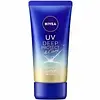What's inside
What's inside
 Key Ingredients
Key Ingredients

 Benefits
Benefits

 Concerns
Concerns

 Ingredients Side-by-side
Ingredients Side-by-side

Water
Skin ConditioningAlcohol
AntimicrobialNiacinamide
SmoothingGlycerin
HumectantBetaine
HumectantPropylene Glycol
HumectantPEG-40 Hydrogenated Castor Oil
EmulsifyingCarbomer
Emulsion StabilisingPhenoxyethanol
PreservativeParfum
MaskingSodium Ascorbyl Phosphate
AntioxidantAllantoin
Skin ConditioningTriethanolamine
BufferingTetrasodium EDTA
CI 47005
Cosmetic ColorantCI 16035
Cosmetic ColorantWater
Skin ConditioningEthylhexyl Methoxycinnamate
UV AbsorberAlcohol Denat.
AntimicrobialButylene Glycol
HumectantCaprylyl Methicone
Skin ConditioningDiethylamino Hydroxybenzoyl Hexyl Benzoate
UV FilterDiglycerin
HumectantIsopropyl Palmitate
EmollientBis-Ethylhexyloxyphenol Methoxyphenyl Triazine
Skin ConditioningDiisopropyl Sebacate
EmollientEthylhexyl Triazone
UV AbsorberBifida Polysaccharide
HumectantSilica Dimethyl Silylate
EmollientCitrullus Lanatus Fruit Extract
Skin ConditioningHydrolyzed Conchiolin Protein
Skin ConditioningPolianthes Tuberosa Polysaccharide
Skin ConditioningSodium Hyaluronate
HumectantPyrus Cydonia Fruit Extract
Skin ConditioningPolymethylsilsesquioxane
Acrylates/C10-30 Alkyl Acrylate Crosspolymer
Emulsion StabilisingLauroyl Lysine
Skin ConditioningHydroxypropyl Methylcellulose Stearoxy Ether
Dibutyl Lauroyl Glutamide
Skin ConditioningC30-45 Alkyl Methicone
EmollientC30-45 Olefin
Skin ConditioningSilica
AbrasiveTitanium Dioxide
Cosmetic ColorantCarbomer
Emulsion StabilisingPhenoxyethanol
PreservativeSodium Hydroxide
BufferingBHT
AntioxidantMethylparaben
PreservativeParfum
MaskingWater, Ethylhexyl Methoxycinnamate, Alcohol Denat., Butylene Glycol, Caprylyl Methicone, Diethylamino Hydroxybenzoyl Hexyl Benzoate, Diglycerin, Isopropyl Palmitate, Bis-Ethylhexyloxyphenol Methoxyphenyl Triazine, Diisopropyl Sebacate, Ethylhexyl Triazone, Bifida Polysaccharide, Silica Dimethyl Silylate, Citrullus Lanatus Fruit Extract, Hydrolyzed Conchiolin Protein, Polianthes Tuberosa Polysaccharide, Sodium Hyaluronate, Pyrus Cydonia Fruit Extract, Polymethylsilsesquioxane, Acrylates/C10-30 Alkyl Acrylate Crosspolymer, Lauroyl Lysine, Hydroxypropyl Methylcellulose Stearoxy Ether, Dibutyl Lauroyl Glutamide, C30-45 Alkyl Methicone, C30-45 Olefin, Silica, Titanium Dioxide, Carbomer, Phenoxyethanol, Sodium Hydroxide, BHT, Methylparaben, Parfum
 Reviews
Reviews

Ingredients Explained
These ingredients are found in both products.
Ingredients higher up in an ingredient list are typically present in a larger amount.
Carbomer is a polymer of acrylic acid. Its main role is to create a gel consistency.
A high amount of carbomer can cause pilling or balling up of products. Don't worry, most products contain 1% or less of carbomer.
Parfum is a catch-all term for an ingredient or more that is used to give a scent to products.
Also called "fragrance", this ingredient can be a blend of hundreds of chemicals or plant oils. This means every product with "fragrance" or "parfum" in the ingredients list is a different mixture.
For instance, Habanolide is a proprietary trade name for a specific aroma chemical. When used as a fragrance ingredient in cosmetics, most aroma chemicals fall under the broad labeling category of “FRAGRANCE” or “PARFUM” according to EU and US regulations.
The term 'parfum' or 'fragrance' is not regulated in many countries. In many cases, it is up to the brand to define this term.
For instance, many brands choose to label themselves as "fragrance-free" because they are not using synthetic fragrances. However, their products may still contain ingredients such as essential oils that are considered a fragrance by INCI standards.
One example is Calendula flower extract. Calendula is an essential oil that still imparts a scent or 'fragrance'.
Depending on the blend, the ingredients in the mixture can cause allergies and sensitivities on the skin. Some ingredients that are known EU allergens include linalool and citronellol.
Parfum can also be used to mask or cover an unpleasant scent.
The bottom line is: not all fragrances/parfum/ingredients are created equally. If you are worried about fragrances, we recommend taking a closer look at an ingredient. And of course, we always recommend speaking with a professional.
Learn more about ParfumPhenoxyethanol is a preservative that has germicide, antimicrobial, and aromatic properties. Studies show that phenoxyethanol can prevent microbial growth. By itself, it has a scent that is similar to that of a rose.
It's often used in formulations along with Caprylyl Glycol to preserve the shelf life of products.
Water. It's the most common cosmetic ingredient of all. You'll usually see it at the top of ingredient lists, meaning that it makes up the largest part of the product.
So why is it so popular? Water most often acts as a solvent - this means that it helps dissolve other ingredients into the formulation.
You'll also recognize water as that liquid we all need to stay alive. If you see this, drink a glass of water. Stay hydrated!
Learn more about Water